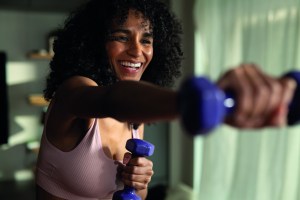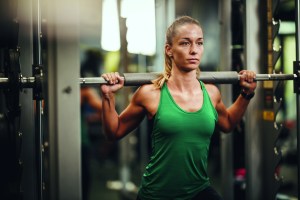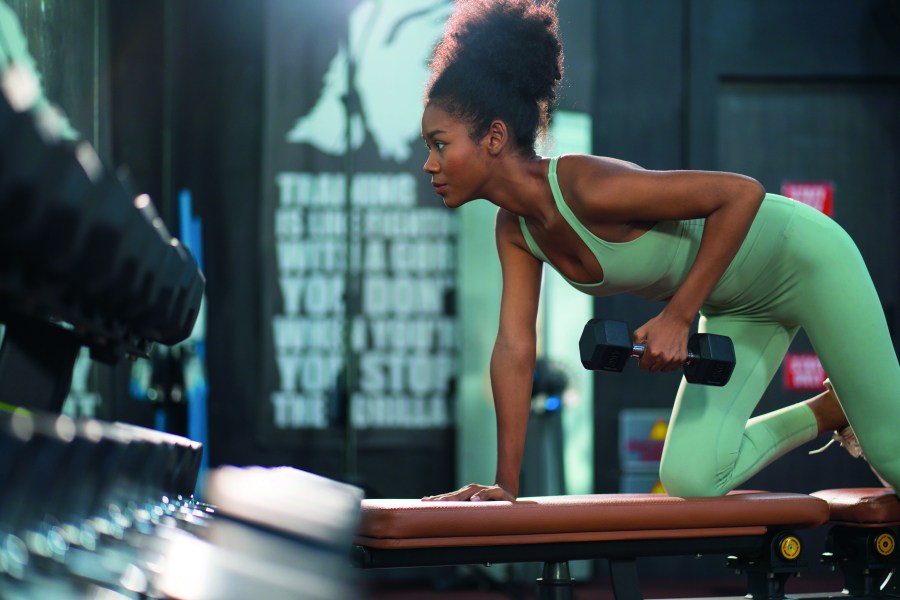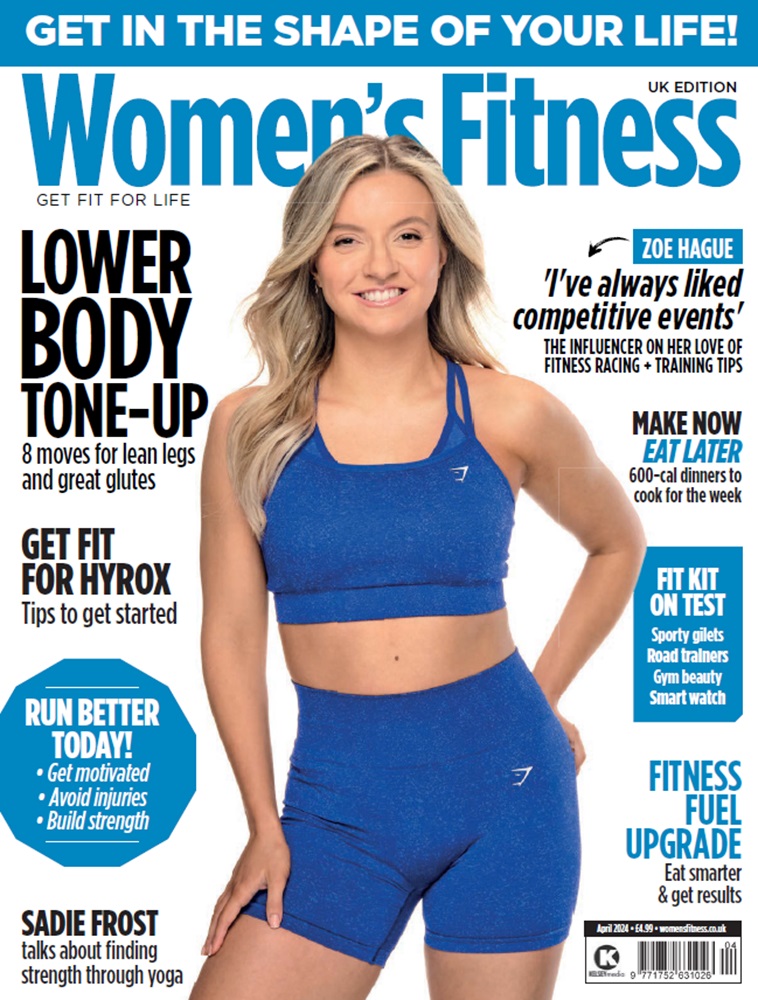Maintaining a toned and strong body is a great fitness and confidence booster. Discover how a little resistance and strength training can go a long way. Words: George Winter.
Whether it’s the satisfying feeling that comes after rearranging heavy patio pots or mastering a strength training or yoga class, there’s a sense of inner confidence that comes with knowing you’re strong – you feel ready to take on the world. Much of this starts deep inside, with your muscles, bones and ligaments. When they’re strong, you can move and carry things with ease, you feel more stable and your posture and performance improves.
Giving your muscles a helping hand to stay robust is especially important as you get older, as muscle protects your bones and braces your internal organs, helping them to function better. Women naturally lose muscle mass after the age of 30 at around two per cent per year. Strength training can help prevent this, but that doesn’t mean you need to spend hours pumping iron. There are lots of everyday ways to strengthen your muscles, and even if you decide to opt for dumbbells, you shouldn’t shy away from heavy ones for fear of bulking up – this doesn’t happen to women as we don’t have the same hormonal profile as men.
Feel balanced and in control
You have 11 main muscle groups: the quadriceps, hamstrings, calves, chest, back, shoulders, triceps, biceps, forearms, abs and trapezius. You can tone up certain areas of your body by recruiting various muscle groups to work together. For example, squats will strengthen your back, glutes and hamstrings, and give you a toned bum and thighs. But, more importantly, by mixing up your activities and getting all your muscle groups working together, you’ll improve your balance and stability.
The chain reaction that happens during exercise improves the communication between your muscles, as well as the nervous system supplying them. ‘This means the signal gets stronger,’ says strength and conditioning coach Nolan Sunnassee (evo-fit.co.uk). ‘The more you practise an exercise or manoeuvre, the more this pattern becomes the norm.’
Take, for example, the yoga pose dancer, known as natarajasana in Sanskrit. You’re balancing on one leg, reaching out with your opposite arm to hold your ankle up behind your back, with your free hand reaching out in front of you. Your quadriceps are activated, tightening right up through your abs to keep you sturdy, while the muscle groups from arm to opposite arm communicate together to balance you further. A bit of practice in this pose and your ‘muscle memory’ will recognise how to fire up all these groups in tandem, so you’ll have the agility of a dancer even when you’re not in the pose!
12 week gym workout plan: cardio & strength training
Strengthen your bones

And it’s not just your muscles that stay stronger for longer when you strength train – your bones benefit, too. ‘Your risk of osteoporosis increases with age, but this can be offset by strength exercises,’ says Dr Jacky Forsyth, a physiologist from Staffordshire University who specialises in women’s exercise (twitter.com/JackyForsyth). ‘Our research found simply doing 10 jumps a day improves your bone health.’ This is because jumping activates your muscles by shortening and lengthening them. So, perform moves, such as squat jumps, at least three times a week. ‘For maximum efficiency, jump without shoes or trainers,’ adds Dr Forsyth.
Further anti-ageing benefits of strength training come by way of boosting certain hormones. When you lift weights, your body produces growth hormone (GH), which helps prevent age-related muscle loss, also known as sarcopenia. GH also balances out other female hormones that might be going out of sync due to the menopause. Finnish scientists found that during the perimenopause, a rapid and dramatic decrease in ovarian hormone production went hand-in-hand with a decrease in muscle performance. They suggested it was because the female sex hormones made by the ovaries, such as oestrogen, progesterone and testosterone, are crucial in helping to regulate muscle tone performance. By using weights, you’re helping to counteract the effect induced by your declining hormones, while keeping your muscles strong, too.
What’s more, certain moves maximise this hormonal response. In a Norwegian study, participants were asked to do a series of arm exercises, such as biceps curls. The researchers found participants performed better if they’d first done weighted leg exercises on gym machines. The leg exercises provided a particular increase in hormone circulation, which led to improved performance with the arm exercises.
Fire up your metabolism
Most people associate cardio workouts, such as running or cycling, with burning fat. However, weight training has just as big a part to play in keeping your metabolism fired up, which keeps excess body fat down. ‘Metabolism comprises all the biological and hormonal reactions that keep your cells and organs functioning,’ says Nolan. ‘When you weight train to a certain intensity, your body has to work harder to repair itself and restore things, such as temperature, to normal in a process called homeostasis. This, in turn, helps your metabolism work efficiently.’
But, unlike slow cardiovascular work, if you exercise with weights, or get your muscles fired up through high-intensity interval training, it raises your metabolism for up to 48 hours afterwards. ‘This effect is called excess post-exercise oxygen consumption,’ says Nolan. ‘It’s when you use an increased amount of oxygen and expend 15 per cent more energy than during your workout, helping you lose more excess fat.’
For fat loss to be even more effective, build up to using moderate or heavy weights, with fewer repetitions – as opposed to lighter weights with lots of repetitions – as the intensity needed ups the fat-burning recovery period. ‘In an Italian study, up to 22 hours after a group undertook high-intensity resistance training, they still had an elevated resting energy expenditure of 452 calories more than the control group, which undertook less intense exercise,’ says Nolan. ‘But if you’re just starting out, it’s important to begin with light weights so you develop the right co-ordination patterns and recruit enough muscle fibres.’

Boost your sporting abilities
To determine what’s light for you, a weight should be less than 60 per cent of the maximum you can lift. If you can’t pick up a 12kg kettlebell, for example, the perfect weight for you is around 7kg (or around 3.5kg in each hand). If you train with moderate weights, which is classed as 70-85 per cent of the maximum you can lift, you get the benefit of boosting your skeletal muscle, which means you’ll be generally stronger and your muscles will take longer to tire.
‘Heavier weights cause micro-tears in your muscles,’ says Glyn Howatson, professor of human and applied physiology at Northumbria University (twitter.com/GlynHowatson). And these tears stimulate your muscles to become stronger.
Whatever strengthening method you choose, you can be confident that you’re also working wonders for your bone health, hormones, metabolism and confidence, too.







